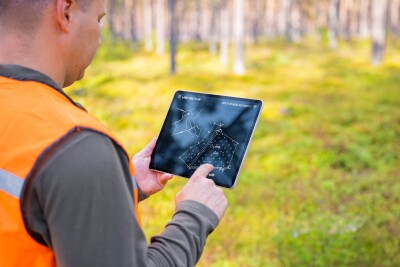The 2009 Leica Geosystems HDS Worldwide User Conference held last week in San Ramon, Calif., had a lot of excellent presentations. One of the show-stoppers was Forensic Specialist Sarah Watson’s riveting talk about how the Los Angeles County Sheriff’s Department uses laser scanning to survey and investigate crime scenes and accidents. Part of a four-person, two-scanner team that is on call 24/7, Watson and her colleague, Deputy Sheriff Steve Tillman, have scanned everything from murder scenes to high-profile accidents in the vast county. In a good year, the 4,100-square-mile area with nearly 10 million people reports about 400 homicides. In a bad year, that figure can more than double. In 2006, the FBI reported 1,012 murders in LA County. Watson was also part of the team that scanned the 2008 Chatsworth Metrolink train collision that killed 25 and injured 135 more last September in LA. The team also deploys scanning whenever there are multiple murders (three or more), and in instances where an officer has perished by gunfire in the line of duty.
Scanning is Good Police Business
It just makes for good police business to collect as much information as possible in these situations; fortunately, scanning is part of the LASD’s risk management plan. One of the challenges of analyzing crime or accident scenes, Watson says, is that what constitutes important evidence may not be obvious until long after the scene has been cleaned up. Scanning provides a means of locating objects in a scene, complete with dimensional information. We may know it was Colonel Mustard in the library with the lead pipe. But where, exactly, was that lead pipe? Scanning provides a tool for collecting details about evidence whose importance may not be appreciated until much later in an investigation and provides a record that is archived for all time. It also assists the self-insured county that finds itself fending off civil lawsuits in nearly every instance where there is an officer-involved shooting and where settlements can reach upwards of $100 million.
Watson reports that scanning is winning over district attorneys and detectives alike, although, she admits, there are some holdouts. While interviewing eyewitnesses is necessary, time consuming and best accomplished as soon as possible following a crime, many detectives are gladly using laser scanning to filter out certain eyewitness accounts by showing that line-of-sight obstructions are physically impossible. As an example, Watson described how the testimony for the defense in an LA County child murder trial was discredited when scanning was used to show the view of the “eyewitness” as being physically obstructed.
Shooting Targets is Different for Police Officers
The LA County scanning team got started in the fall of 2007 with the purchase of two Leica ScanStation 2 scanners. Funding came from both technology grants and forfeiture accounts. Watson explained that the ride was rough in the beginning and that the team had to learn to “speak scanning.” Law enforcement personnel have something quite different in mind when they hear “shooting targets” than do scanner technicians. Watson lauded the efforts of Leica’s Tony Grissim and team in developing training materials specifically for law enforcement–materials that have been used to train other law enforcement departments around the world. Watson also said that more evidence of the deep commitment of her senior management to the scanning program was that each of the four scanning team members keeps in practice by scanning at least once per week, which is a heavy training commitment for a 22-member crime scene team.
The LASD deploys lighting balloons, a Nodal Ninja panoramic tripod head to capture 360-degree photographs and generators to support jobs that can last 18-20 hours. Often, both of the department scanners are deployed at the same scene to speed up data collection. Leica TruView viewing and measuring software is used to present evidence in the courtroom. Watson reports that juries and judges alike grow to appreciate the ability to navigate the scene without having to sift through dozens of still images. The TruView files are archived in perpetuity. Accredited by the American Society of Crime Laboratory Directors since 1989, the LASD’s Scientific Services Bureau gets its scanners calibrated every year and conducts validation studies for all its equipment.
Following Watson’s presentation, Leica’s Public Safety and Forensic Account Manager, Tony Grissim, drew my attention to the murder trial of Antonio Jerome Greenlee in Decatur County Superior Court in Georgia where laser scanning data and associated TruView images were admitted as evidence in court by District Attorney Joe Mulholland of the South Georgia Judicial Circuit. Grissim says that the judge and jurors appreciated the effectiveness of the TruView presentation and that the defense had no objection to its use.
The citizens of LA County ought to be very proud of the LASD scanning team. They’ve blazed a new trail in the use of 3D imaging for their important work and brought some fresh thinking not only to their own departments but to the rest of the scanning community.
Hats off to them!





